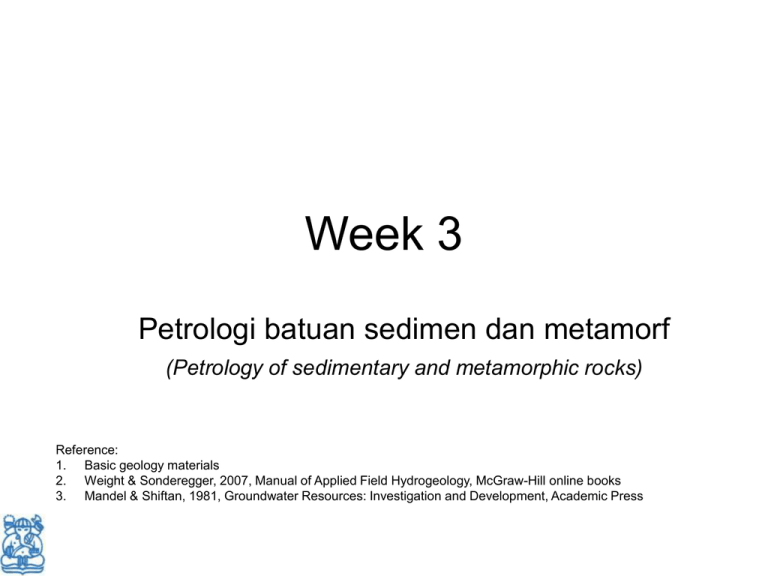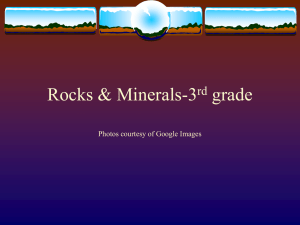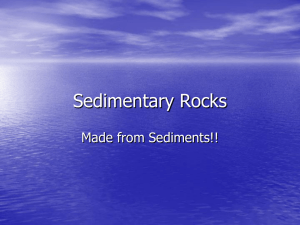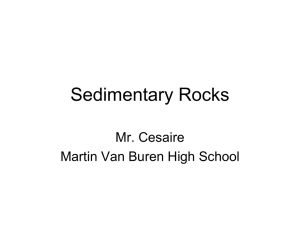Petrology of sedimentary and metamorphic rocks
advertisement

Week 3 Petrologi batuan sedimen dan metamorf (Petrology of sedimentary and metamorphic rocks) Reference: 1. Basic geology materials 2. Weight & Sonderegger, 2007, Manual of Applied Field Hydrogeology, McGraw-Hill online books 3. Mandel & Shiftan, 1981, Groundwater Resources: Investigation and Development, Academic Press Sedimentary Rocks Sediments are loose particles of former rocks; sediments form by weathering those previous rocks. Sediments can either be clastic particles (bits of rock ranging in size from mud grains to boulders) or material which was dissolved, then precipitated chemically or biochemically. Sedimentary rocks come in two major classifications: clastic and chemical/biochemical. Clastic rocks are made from solid particles of previous rocks; examples of clastic rocks are sandstone, shale, and siltstones. Chemical/Biochemical rocks are made from sediments precipitated from water either chemically or biochemically; examples are limestone, chert, and rock salt. GENESIS OF SEDIMENTARY ROCKS 1. Weathering Material is worn off of existing rocks by wind, rain, and the like. The material can be either clastic particles or dissolved stuff. 2. Erosion This weathered material is split away from the parent rock by mechanical and/or chemical means 3. Transport The eroded material is moved downstream toward a lower elevation by wind, water, or ice. 4. Deposition The material is deposited at another location. 5. Burial If the sediment is left undisturbed long enough, and sedimentation continues, it will be buried by more sediment later. If this process continues for a long time and the sediments remain undisturbed, quite thick stacks of sediment can be built up. 6. Lithification Through various physical and chemical means, sediments are hardened and turned into sedimentary rocks. We say the sediments have been lithified. Metamorphic Rocks Metamorphic rocks are formed when the mineralogy, and/or texture of previously-existing rocks are changed. The primary agents which change rocks are: • Heat (temperature) • Pressure (aka stress) • Fluids (hydrothermal) There are many different kinds of metamorphism. A few of the more common are: • Regional Caused by moderate-to-high pressures and/or temperatures over a large region; found in continent/continent collision zones, subduction zones, and such. • Contact High temperature/low pressure environment found when an igneous body intrudes pre-existing rocks. • Hydrothermal Changes caused by fluids circulating through rocks; found commonly at mid-ocean ridges. These occur in different pressure/temperature/fluid environments and over different length scales. Definition Hydrostratigraphy is the identification of mappable-units on the basis of hydraulic properties (aquifer / aquitard) that have considerable lateral extent and that also form a geologic framework for a reasonably distinct hydrogeologic system. MJR Hydrostratigraphy Stratigraphic Surficial Deposits Floral Fm Lithologic Hydrostratigraphic Clay Surficial Aquitard Sand Floral Aquifer Till Floral Aquitard Empress Gp Sand & Gravel Empress Aquifer Bearpaw Fm Shale / Mudstone Bedrock Aquitard Hydrostratigraphic Units Unit #1: Isotropic Aquitard Unit #2a: Anisotropic Aquitard Kv>>Kh Unit #2b: Isotropic Aquitard Unit #3: Isotropic Aquifer Unit #4: Isotropic Aquitard Unit #5a: Fractured Bedrock Aquifer Unit #5b: Unfractured Bedrock Aquifer











